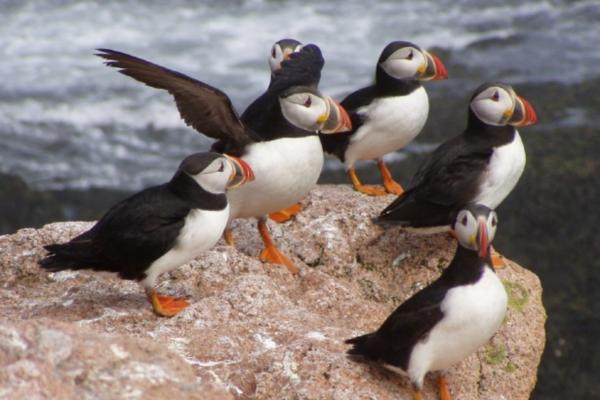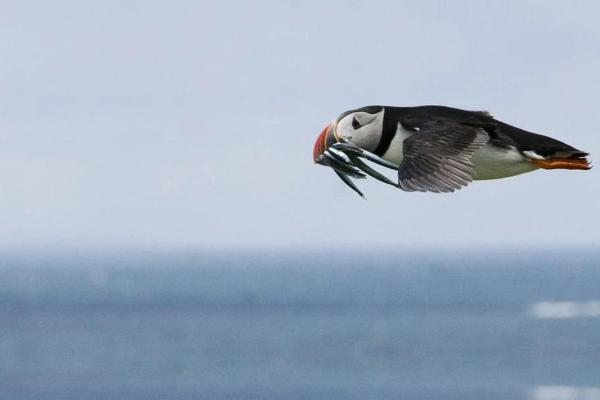In the icy northern latitudes, several bird species have adapted remarkably well to harsh coastal environments. Among them, the Atlantic puffin (Fratercula arctica) stands out with its colorful beak, tuxedo-like plumage, and adorable appearance. Often mistaken for a penguin, this seabird has captured the fascination of bird lovers worldwide.
In this article, we’ll dive into everything you need to know about the Atlantic puffin — from its physical traits and habitat to its diet and breeding habits. If you've ever wondered “Is a puffin a penguin?” or “Where do puffins live?”, keep reading.

Scientific name: Fratercula arctica
Common names: Atlantic puffin, sea parrot, clown of the sea
Size: Medium-sized bird — about 30 cm (12 in) in body length with a wingspan of 60 cm (24 in)
Beak: Iconic, large, and brightly colored with hues of red, yellow, and black, especially vivid during the breeding season
Plumage: Black back and white belly and face, resembling a monk's robe — hence the genus name Fratercula (“little friar” in Latin)
Adaptations:
Short, strong wings used for “flying” underwater while hunting fish
Webbed feet help with maneuvering in water
Specialized nasal glands that excrete excess salt from seawater
Not a penguin: Although puffins resemble penguins, they belong to different orders — puffins are Charadriiformes, penguins are Sphenisciformes
Vocalization: Mostly silent except when communicating with chicks
Global population: Around 5 million breeding pairs
Atlantic puffins are marine and coastal birds primarily found in the North Atlantic Ocean, including Arctic waters. Their range includes:
Countries: Iceland (hosts over half of the world’s population), the UK, Ireland, Norway, Greenland, Canada, Northern France, and parts of Scandinavia
Islands & Coasts: Newfoundland, Labrador, and other North Atlantic islands
Seasonal patterns:
Winter: Puffins remain offshore in open sea
Spring/Summer: Return to land for breeding, often nesting in grassy slopes, cliffs, or remote islands
Migratory visitors: Occasionally seen in coastal Spain (e.g., Valencia, Alicante, Murcia) during winter

As seabirds, puffins rely entirely on the ocean for food. Their diet primarily includes:
Small fish: Anchovies, sand eels, capelin, herring
Crustaceans: Shrimp and similar small aquatic invertebrates
Hunting method:
Puffins dive to depths of up to 60 meters (200 feet) to catch prey underwater
They swallow prey whole to avoid theft by other seabirds
Their tongues have serrated grooves, helping them grip multiple fish at once

Puffins come ashore only during the breeding season, which begins in spring and summer.
Breeding signals:
Beak becomes even more colorful: blue-gray at the base, yellow lines, red tip
Eye ring turns red — both enhance visual attraction
Nesting behavior:
Puffins dig burrows in grassy cliffs or reuse old rabbit holes
Nests are lined with soft material like feathers or grass
Mated pairs often return to the same burrow each year, forming part of large breeding colonies
Egg & chick care:
Each pair lays one egg
Both parents share the 40-day incubation period
Chicks (pufflings) are born with dark feathers and black beaks
After 40 days, they leave the nest to begin independent life at sea
Adult plumage and colorful beak develop by around 2 years of age
Bibliography
Encyclopedia of Birds of Spain. (n.d.). Atlantic Puffin. Available at: https://seo.org/ave/frailecillo-atlantico/
Kauffman, K. (2005). Field Guide to the Birds of North America. New York: Hillstar Editions.
SEO/BirdLife. (n.d.). Atlantic Puffin. Available at: https://atlasaves.seo.org/ave/frailecillo-atlantico/
animal tags: Atlantic Puffin
We created this article in conjunction with AI technology, then made sure it was fact-checked and edited by a Animals Top editor.